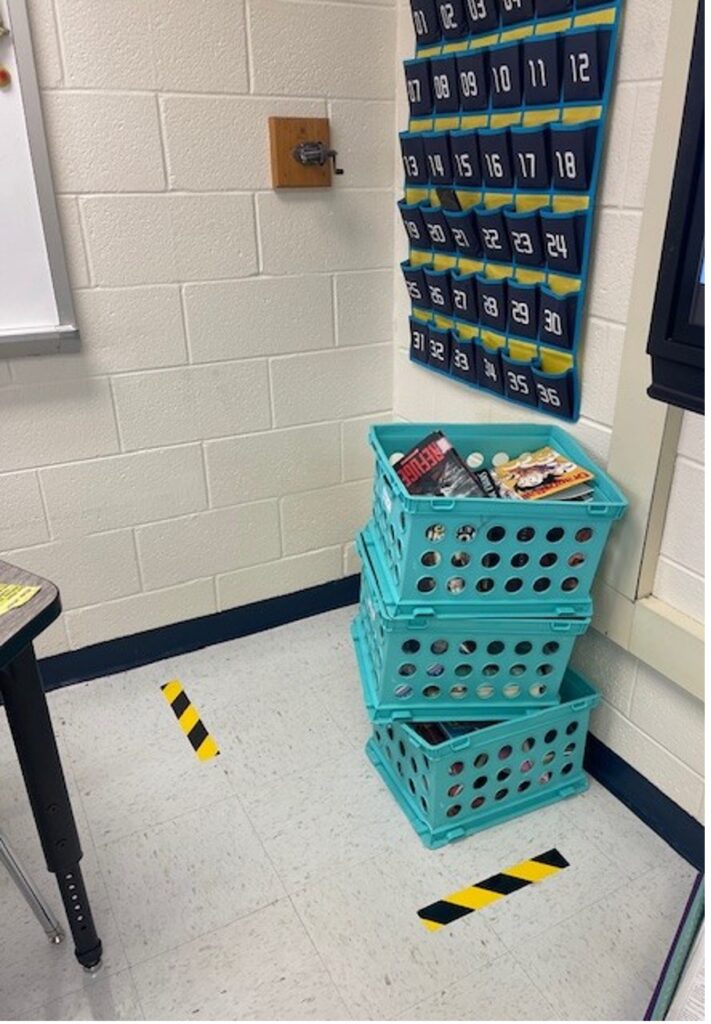There are now statewide laws or orders in 14 states mandating that schools operate as phone-free environments. Many districts and school systems are following suit with their own no-phones policies. In 2024, Governor Glenn Youngkin signed an executive order issuing just such guidance in the state of Virginia. As a result, my school district adopted a policy prohibiting the use of cell phones during instructional time just before the beginning of the 2024-2025 school year.
As more and more districts adopt a “no phones” approach, many teachers may be facing this new policy in their own schools this coming school year. As a high school teacher who strictly (and effectively) enforced a no-phones policy in her classroom this past school year, I want to share my experience with teachers who may be wondering if a phone-free policy can really work in public school.
Things to consider before school starts
Before the school year begins, it’s crucial to have a thought-out plan already in place. When deciding how a no-phones policy will work in your classroom, here are some considerations to make before the first day.
Storage
The first consideration is where the students will store their phones. It’s important that student phones are not stored in their pockets or backpacks. That ease of access will negate the intention and purpose of a no-phones policy. My school ordered good-old-fashioned “shoe pouch” organizers for all classrooms. That’s what I recommend using. These canvas pouches are inexpensive and easy to hang. Plus, they don’t require much on the teacher’s part to manage. Teachers at my school could choose a storage method that worked best for them. Some allowed charging stations in the back of the room. Others collected phones in plastic storage bins.
Here’s the hanging pouch organizer I used for phone storage in our classroom. (The caution tape is a school safety requirement unrelated to the phone pouch! In this classroom, this is the designated “safety corner” in an emergency event.)

Location and security
Students may express concern that if their phone is not with them, it’s at risk of being stolen or damaged. To assure them that their phones are safe, secure the storage device in an area of the room that is not near a door and that students cannot easily access or pass by. In my room, I drilled the storage pouch into the wall at the front of the room beside the board. This secure mount meant there was no concern of phones falling out and getting damaged. Additionally, students always had eyes on their phone and no students were able to access the phone pouch without bypassing the teacher. Consider the best area in your room to place your phone storage to ensure that phones won’t be damaged or easily accessible to students.
Accountability
It’s important to have a way to track whose phone is in the pouch and whose isn’t. My co-teacher and I labeled each desk with a sticker that matched a numbered pouch on the organizer. When students received their assigned seat, their pouch number matched their desk number and this remained their assigned pouch. If students are simply asked to place their phones up without a tool for accountability, it will be difficult to determine which students did not comply, which makes the policy difficult to enforce.
Sounds easy, right? Now comes the fun part: getting the kids to go along with the plan.
First-day “musts”
A common adage in teaching is “Begin how you intend to finish.” My co-teacher and I were in full agreement early on. The phone-free policy would be in place from day one through the last day of school. Consistency in implementation is the key to success when it comes to getting students to follow a policy. Especially one that, in all honesty, they’re not fans of.
Instruct, don’t ask
In the book Lemons to Lemonade, authors Zimmerman and Garmston share strategies for effective communication in schools. They explain the difference between an “approachable” voice that invites and a “credible” voice that gives clear direction. When students entered the room on the first day of school, my co-teacher and I used a “credible” voice vs. an “approachable” voice when providing instruction to place their phone in the pouch.
A teacher using an approachable voice might ask, “Would you mind putting your phone in the pouch?” While this might feel friendlier and more comfortable, it invites options. The student could respond that they do mind and will not be complying.
Alternatively, a credible voice says, “Your desk number is 12. You will be placing your phone in pouch 12.” Issuing a directive in a credible tone and proceeding with the expectation that it would be met encouraged the students to follow through on the direction.
Build buy-in
To encourage student buy-in, my co-teacher and I agreed that we would put our phones in a pouch as well. (We faithfully tucked our phones into pouch numbers 1 and 2 all year long.) By showing that we felt comfortable following the policy, students were that much more willing to follow our direction. (Understandably, there may be situations in which a teacher is unable to put their phone in the pouch, in which case having it out of sight and not in use would still be effective.)
Hearing out the students’ concerns about the policy was important to build trust and rapport in those first days. Many students will express a concern that without their phone, they won’t be able to contact family in an emergency.
We reassured them that not only would they be safer in the moment if they could hear our directions without distraction, but that eventually they’d be able to get their phones from the pouch and make contact. The phones aren’t gone, they just aren’t immediately accessible at all times. Making that distinction is important.
Clear is kind
To set expectations early, we gave a clear explanation of the way the policy would work in our classroom. These procedures may vary from classroom to classroom, but it’s important that the procedure is consistent in every class block. Each day when the bell rang, students would place their phones in their assigned pouch. Two minutes before the final bell (and no sooner), students would be able to retrieve their phones from the organizer. My co-teacher and I never deviated from this structure. It may be tempting to allow students to retrieve their phones once they’ve finished their work, or if the schedule for the day has shifted, but we never wanted access to the phones to be seen as a “reward” they were trying to earn.
Included in the usual slides of class rules and expectations, we added a screenshot of the school board phone policy itself. Even if they don’t agree with it, students are typically appreciative of hearing an explanation or a rationale for a policy. This also let them know that, although we agreed with the policy, it ultimately wasn’t our choice whether to follow it or not. This additional support is useful when enforcing expectations and consequences.
So does it work? From day one?
You may be rolling your eyes at the idea that it was just that easy to “ban” the phones. To be clear, we did receive some pushback in the early days. There were some students who chafed at having to “give up their property.” There were students who claimed they “didn’t have their phone today.” Some students who were compliant in weeks one and two became a bit more intolerant in week three. At that point, the shininess of the new school year began to wear off, and they saw that we weren’t becoming more lax about the phones. (And yes, they do try to use “dummy phones” and empty phone cases as decoys.)
We anticipated and worked through these obstacles as they arose. If students became argumentative, we reiterated that the policy was a district and state requirement. When students would say, “I don’t have my phone,” my chosen response was “Everyone has their phone.” This was exceptionally effective. It didn’t antagonize the student or levy an accusation. But it was enough to pierce their ruse, and they’d almost always get up and put away the phone they did have. (Sometimes, they truly didn’t have it. You can often tell when that’s the case—or call home to confirm.) Only once was a backup call to the admin team required—for especially reluctant students, this should be a last resort, but one you are not afraid to use if needed. It isn’t picking a fight, it’s staying consistent, and it makes all the difference.
Eventually, all the pieces just fell into place. By the third quarter, there were many days when by the time I completed my pouch check, all students had already put their phones away without any reminder—the beauty of a well-established routine.
It’s helpful to note that this may not be the case school-wide. Uniform enforcement of the policy throughout the building is ideal but not always achievable. So it will be up to you to manage the phone policy in your own room. As the year wore on, students would tell me I was one of their only teachers still strict with the phone policy. There may be variance within your school building as well. But as long as the routine you establish continues to work well in your classroom, that’s all that matters.
Is it worth it?
Does the idea of a phone-free classroom sound time-consuming and tedious? It isn’t. Taking a few minutes at the start of each class to do a phone check saved us so much instructional time. We no longer had to repeat “Please put your phone away” only to turn around and see the same student scrolling again.
Not only did this preserve the momentum of class and allow us to deliver more clear and engaging lessons, it had the unexpected consequence of improving the teachers’ relationships with the students. When students struggle with responsible phone use, the number of negative interactions a teacher might have with that student can outnumber the positive. Frustrations abound. With the phones safely tucked in their pouches, classroom friction was reduced and I developed deeper, more genuine bonds with students than I have in years.
Even better? The students’ relationships with one another improved. Without a phone to escape to, students talked to each other more. Partner and group activities had better outcomes because the entire group was engaged during instruction and understood the task.
Academic outcomes served as testament to the power of the phone-free classroom. Students were more engaged during class, and this translated to a deeper understanding of the material. They were more focused during work time, and this showed in the quality of the work they turned in. Missing or late work was rarely an issue as there was no reason to not complete the work in class when the screens weren’t there to distract.
Although they were sometimes reluctant to admit it, many of the students agreed that ultimately, the no-phones policy did improve their grades and their academic performance. Were they fans of how strict we were in enforcing the policy? Not always, but the predictability and consistency helped to create a safer, less stressful learning environment that they eventually relaxed into and came to appreciate.
Now what?
In the final weeks (or days) before the new school year begins, take the time to envision what your classroom might look like without phones. How can you make that happen? Even with the support of a district policy, it will ultimately be up to you to manage the policy within your room. Create a plan now for how you’ll implement, enforce, and maintain a fully phone-free environment and then trust yourself to do it—the academic and social benefits of doing so pay dividends.
Final tips and reminders
- Consistency, consistency, consistency. Name the routine on day one and implement it faithfully each day. Stick to the routine and hold each student to the same expectation.
- Physically touch the organizer as you complete your check each day. This will allow you to catch any empty phone cases, dummy phones, or, in one memorable instance I experienced last school year, a cologne bottle a student had used in place of a phone:

- Use positive language! Framing is everything. Remind the students of the benefits of a no-phones classroom and how much they’ll appreciate it in the end. (And however grudgingly, most of last year’s students eventually admitted that they did appreciate the improvements they saw in their own participation and academic success, even if they still wished they had their phones.)
- Avoid the trap of allowing students to access their phones as soon as they finish their work. This can lead to them rushing just to get their phone back. Establish a set time at which everyone can retrieve their phone, and stick to it.
- Make sure that your class is designed to support a no-phones policy. Lessons should be engaging, robust, and devoid of “downtime” in which students will have little to do. For early finishers, have paper activities on hand for them to complete—we always kept word searches, sudoku, coloring sheets, and crossword puzzles stocked in case anyone had time to fill. Your lesson ended just a few minutes early? Hold the line! Pull up Wordle, Connections, or Contexto on your smartboard to engage the whole class in a phone-free activity.



